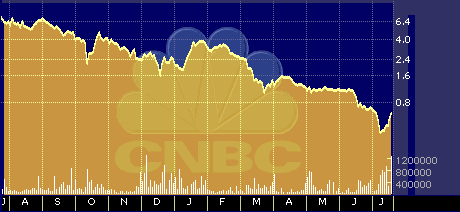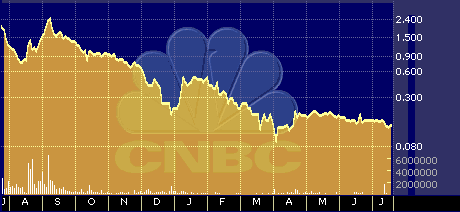
IPO MedicaLogic Off to Good Start
IPO MedicaLogic Off to Good Start
by Hal Plotkin
Silicon Valley Correspondent
Shares of MedicaLogic Inc. {MDLI} are already profiting from the concept of putting medical records online, debuting at 25 on Friday morning.
The initial public offering of 5.3 million shares priced late Thursday at $17, above an original range of between $14 and $16.

MedicaLogic post-IPO stock performance
“As [the company brings] more medical records online, its opportunity expands exponentially,” says U.S. Bancorp Piper Jaffray analyst Daren Marhula.
The promise of Healtheon may be the marching song of the Internet: Take outdated methods, make them faster and profit from a stock run-up.
MedicaLogic’s success could come at the expense of some better-known online health-care firms, such as Healtheon/WebMD Corp. {HLTH}, based in Santa Clara, Calif., and Austin, Texas-based DrKoop.com Inc. {KOOP}, which are also eyeing the same general market.
MedicaLogic, based in Hillsboro, Ore., was originally established in 1985, specifically to computerize patient medical records.
The company’s database already contains more than 7 million individual patient records, which company officials say represent 56 percent of the existing market.
MedicaLogic’s transformation into an Internet company recently got a $35 million boost from a group of investors that includes George Soros’s Soros fund and Sequoia Capital, based in Menlo Park, Calif. MedicaLogic had $16.1 million in revenue in 1998.
In general, online patient records fall into two categories: personal medical records and electronic medical records.
PMRs are self-reports, while EMRs are official medical records used by doctors and pharmacists. Once a patient has an online EMR, any physician with Internet access and the proper permission can immediately obtain the patient’s records, including x-rays, films, and tapes. Rapid access to complete medical records online offers many advantages for both patients and the medical-services industry, from saving lives to boosting productivity and cutting costs.
Marhula says long-term leadership in the online health-care sector could hinge on which company captures the greatest EMR market share. Consumers, Marhula says, may be more likely to seek out medical information, services, and products on the Web site that houses their own medical records.
“Looking two or three years down the road, patient records are going to drive a host of new business opportunities,” Marhula says. It’s similar to the strategy Internet finance sites use by offering visitors the opportunity to register their stock portfolios online. “It gives them a reason to keep coming back,” he adds.
At least one other analyst disagrees. “I don’t think it will be a tool to leverage eyeballs,” says Richard Lee, an analyst at Wit Capital. “Most people probably won’t want to see their own records.”
MedicaLogic is determined to prove Lee wrong. The company recently created a beta, or test, Web site that’s already providing several thousand patients online access to their own medical records.
Overall, the market opportunity related to new Internet health-care business applications is huge. The United States spends about 15 percent of GDP, or an estimated $1 trillion each year, on health care. About $11 billion was spent on health-care information systems and services in 1997, a figure Piper Jaffray expects to double to $22 billion by 2002.
“There are going to be a select handful of winners in each [health-care] category,” Lee says. “That’s why this is such a wide landscape and broad market. Even the small niches are several billion dollars.” For example, Lee says, the annual market for chemical reagents used in medical tests is, by itself, worth more than a billion dollars.
Leading online health care-related companies employ very different strategies. Some, such as DrKoop.com, focus primarily on offering health-related content for consumers, hoping to build a mass audience. DrKoop.com’s stock has fluctuated widely since its IPO earlier this year.

KOOP stock performance since its IPO
Recently, PCData, based in Reston, Va., ranked DrKoop.com the No. 1 dedicated health- care Web site, with more than 1.4 million unique visitors last month, up 59 percent from June.
Even so, the popularity of DrKoop.com pales by comparison with the much larger audiences pulled in by leading general interest Web sites. The Sony Web site, for example, attracted more than four times as many visitors last month.
A recent report from Wit Capital stated, “Even the most trafficked health-content Web site is not in Media Metrix’s top 200, and it is still too early to predict whether any e-Health site can generate enough users to be considered a true vertical portal.” As a result, it’s not clear if sites such as DrKoop.com can derive enough revenue from advertising to assure future success.
Healtheon/WebMD, meanwhile, is focused more directly on tapping health-related e-commerce opportunities. In the past few months, the company has announced several mergers it says will drive more transactions through its Web site. Those acquisitions include MedE America, a provider of health-care transaction products, WebMD, specializing in online communities for physicians and consumers, and Greenberg News Service, which created Medcast, another leading medical-information service used primarily by physicians.
On Nov. 12, Healtheon/WebMD reported third-quarter revenue had more than doubled from the year-earlier quarter, reaching $28.7 million. The company posted a loss of 24 cents, compared with 26 cents during the third quarter of 1998.

HLTH stock performance since its IPO
MedicaLogic’s vice president for Internet marketing, Cameron Lewis, says that as online health-care companies battle for dominance on the Web they’ll discover they have underestimated the importance and complexity of putting patient medical records online.
“We have 14 years of user-interface design experience,” Lewis says. “The thought that a new company can come along and do it as well as we do is a bit far-fetched.”
If Lewis is right, the race between MedicaLogic and its better-known rivals could turn into a classic tortoise and hare story.


